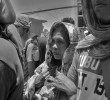By the National Union of Journalists of the Philippines
MANILA (NUJP/July 26) — On July 27, when President Gloria Macapagal-Arroyo delivers what is supposed to be her final state of the nation address before the constitutionally mandated end of her term in June next year, we expect her, of course, to give a glowing account of her nine years in power.
We have no intention of disputing her claims. But for the Philippine media, the Arroyo administration will be remembered for a legacy of bloodshed and repression, its acts of omission and commission nurturing the impunity with which the enemies of press freedom have operated.
By the time she steps down, Arroyo’s watch will have seen a death toll accounting for more than 60 percent of the journalists murdered since the supposed democratic restoration of 1986 and almost twice that under the 14-year Marcos dictatorship.
Only in three cases have we seen convictions under her term, but only of the gunmen, none of the masterminds.
As for repression, it can be argued that no administration has shown such open contempt and hostility toward media or been so cavalier with the constitutionally guaranteed rights to freedom of the press and of expression than this one.
How else would one interpret then justice secretary Raul Gonzalez’s quip that most of the slain journalists were either womanizers or involved in drunken revelry, or First Gentleman Mike Arroyo’s making the then dying Dipolog broadcaster Klein Cantoneros an example of what befalls supposedly irresponsible media practitioners during a speech before the Negros Press Club a few years back?
No government since the dictatorship has attempted a wholesale clampdown on the media as Arroyo’s did during the short-lived state of national emergency she declared in 2006.
Not only did her storm troopers raid the Tribune and tramp threateningly through the parking lots of the two major broadcast networks, Cabinet Secretary Ricardo Saludo even had the temerity to threaten the takeover of a network that was interviewing live because it had allowed a military mutineer to say his piece.
And who can forget the sight of some 50 journalists marched off to a police camp in the aftermath of the Manila Peninsula takeover, their sole crime the performance of their duties; or the brief detention of as many journalists covering the humanitarian crisis in central Mindanao by Army soldiers in Maguindanao province?
It has also been under this administration that security forces have openly branded media organizations as “enemies of the state,” as the Intelligence Service of the Armed Forces of the Philippines did in its infamous “Knowing the Enemy” PowerPoint presentation in 2005, and the Army’s 10th Infantry Division with its recently discovered order of battle.
We would like to stress here that we have received reliable reports that, notwithstanding the military’s promise that it would pull the “Knowing the Enemy” presentation, it has continued to be shown in schools and urban poor communities in Metro Manila.
Neither did Arroyo lift a hand when her husband wielded the antiquated libel law like a bludgeon, filing multiple suits against 46 journalists in what was a clear abuse of his powers and privileges.
Nor did Arroyo rein in House Speaker Prospero Nograles from using the same law to torment broadcaster Alex Adonis.
Neither has she shown any inclination to exercise her influence over her congressional allies to stop them from further pushing the right of reply bill, which would place control of media content in the hands of politicians hungry for power and fame.
This administration’s animosity toward freedom of the press and of free expression takes other forms as well, such as the censorship and prior restraint exercised by the Movie and Television Review and Classification Board in requiring public affairs programs to submit their tapes for review before these can be aired, or slapping “X” ratings on films critical of government.
It should also be stressed that under the nearly nine years of the Arroyo administration, no measure has been passed to improve the living and working conditions of journalists and media workers. Most of them suffer low wages and lack of job security and benefits amid the growing risks of attacks and killings, especially in the provinces.
If the Philippine media remain free, it is no thanks to this administration’s lip service professions of respect for the freedoms of the press and free expression but rather to the tenacity with which Filipino journalists have resisted all attempts to cow them into submission and silence.
It is a tenacity that will see the independent Philippine media remain so on the very day Arroyo steps down from power and beyond.
Signed by the NUJP National Directorate, 2008-2010:
Nestor Burgos (Philippine Daily Inquirer), chairperson
Nonoy Espina (freelance), vice chairperson
Sonny Fernandez (ABS-CBN), secretary-general
Alwyn Alburo (GMA7), deputy secretary-general
Rowena Paraan (PCIJ), treasurer
Marlon Ramos (Philippine Daily Inquirer), auditor
Julie Alipala (Philippine Daily Inquirer), director
Day Caluza (Philippine Daily Inquirer), director
Cheryl Fiel (davaotoday.com), director
Jun Godoy (dxOC), director
John Heredia (News Today), director
Danny Lucas (ABS-CBN), director
Ilang-Ilang Quijano (Pinoy Weekly), director
Arnell Ozaeta (dzMM), director
May Rodriguez (freelance), director

![[STANDPOINT] Illegal drugs and the NIMBY mindset](https://davaotoday.com/wp-content/uploads/2016/09/Mags-Maglana_UPMIN-Sept.-20-110x100.jpg)








